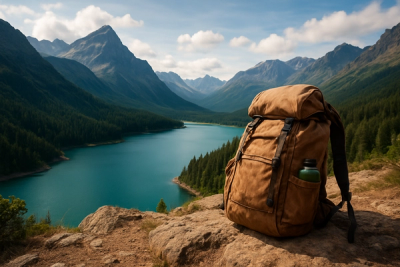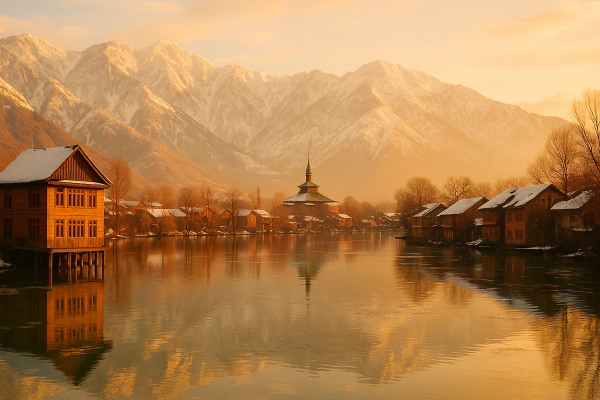Festival Adventures: Exploring India’s Spiritual Hotspots in 2025 — messy, magical, and kinda unforgettable#
Um, so, India during festival season. It’s that mix of incense smoke and diesel and masala chai that hits your nose at 6am and you’re just like… wow, okay, we’re doing this. Even planning it feels like a pilgrimage, honestly. The energy is big, sometimes chaotic, but the spiritual vibe? It sneaks up on you. Even if you’re just there to, you know, watch and eat and wander, you end up feeling something.¶
2025 travel basics you should actually know before you go#
Quick stuff first because I wish someone had told me all this in one go. Visa-wise in 2025, most travelers still use India’s official eVisa for tourism — there’s the 30-day, 1-year, and 5-year options, generally multiple entry on the longer ones. Fees vary by nationality and change, so don’t get stuck on last year’s Reddit threads. Apply at the official government portal only, processing can be a few days, sometimes longer around peak festivals. No pandemic tests or quarantine now as of 2025, but remember temple towns have their own rules — bag checks, no drones, sometimes phone restrictions during aarti, footwear counters, that sorta thing.¶
Money wise, UPI is everywhere, like literally chai stalls and temple donation counters, but if you don’t have an Indian bank account there’s no guarantee your international card will hook into UPI. Some travel cards and apps offer workarounds, but carry cash anyway. ATMs are fine in most cities, less so at temporary festival camps. E-SIMs are basicly easy in metros, 5G in bigger hubs, not guaranteed in remote pilgrimage routes.¶
Prayagraj Maha Kumbh 2025 — the big one#
The Maha Kumbh happens every 12 years and 2025’s edition at Prayagraj is, yeah, monumental. Picture this: confluence of the Ganga, Yamuna, and the mythical Saraswati, dawn mist off the water, a million feelings and like several million people. You get these morning processions, saffron robes, bell clangs, the ritual bathing days — called Shahi Snan — are the absolute peak and the crowd swell is unreal. Authorities have layered on extra crowd control this year, designated entry points, barriers, and yes, lots of loudspeaker announcements. It’s spiritual, and intense, and honestly a little overwhelming.¶
Practical bits for 2025: book way ahead. Camps and dharamshalas can be barebones and fill fast. Temporary tent cities pop up along with basic medical posts. Expect road diversions weeks in advance. If you’re not staying at the Sangam, base in Allahabad city and start brutally early. Also hydration — the heat spikes can be rough even in Jan–Feb during midday, and toilets are… let’s say, variable. Keep your daypack minimal because security checks can be slow.¶
Safety tips that saved me stress (and probably you too)#
- Avoid Shahi Snan days unless you’re mentally okay with shoulder-to-shoulder crowds, even then choose a safer ghat zone and follow police instructions
- Keep a hard meeting point with your travel buddy since phone signal can drop
- Stay on marked walkways, don’t push into processions for photos — it’s not a parade, it’s devotion
- Check official advisories the night before; routes sometimes change last minute
Ayodhya in 2025 — Ram Mandir and the city finding its rhythm#
Since the Ram Mandir inauguration in early 2024, Ayodhya has been absolutely booming. There’s a new airport with expanding flights from Delhi, Mumbai, etc., and Vande Bharat trains cutting the travel time. On festival days (Ram Navami, Diwali, even regular weekends), timed darshan windows and long queues are normal. Expect airport-style checks, lockers or footwear counters, and strict no-drone zones. Don’t bring big bags to the temple core, you’ll waste half your day in security loops.¶
Prices have jumped. In 2025, budget stays hover around 1500–2500 INR per night if you book ahead, midrange often 4000–8000, and the nicer new builds go 12k and above, especially near the temple corridor. Homestays go fast during big dates. Book two months in advance minimum, three if you’re picky. Oh and temples in Ayodhya tilt vegetarian — many eateries are pure veg and close early, so plan your dinner. Street sweets are everywhere though, and it’s not not an issue if you eat three laddoos as a meal. I mean, I wouldn’t judge.¶
Varanasi — Dev Deepawali, Ganga aarti, and that feeling you carry home#
Varanasi during Dev Deepawali (usually in November) is the city gone gold. Hundreds of thousands of diyas on the ghats, everything glowing. Evening aarti at Dashashwamedh Ghat is already packed on normal days, but festival nights get wild. In recent years there’s been better fencing and lanes to control entry, but you still need to arrive early or watch from a boat — which honestly, is magical in a sit-back-and-let-it-wash-over-you way.¶
Accommodation in 2025 got pricier, not shockingly, just… upward. Ghat-side guesthouses can be as low as 2000–3500 INR, but anything with a balcony view spikes during festival weeks. Boutique stays are 6000–12000. If you can’t find ghat rooms, look inland near Assi or Sigra and just walk down — it’s fine. Also, please don’t underestimate the stairs. Your calves will write angry emails.¶
Haridwar and Rishikesh — aarti, yoga, and the river that keeps moving you#
Evenings in Haridwar at Har Ki Pauri have this simple, steady aarti that pulls you quiet even if the market chaos is like five meters away selling glow sticks and postcards. Rishikesh in 2025 is still a yoga hotspot, with retreats ranging 2500–7000 INR per night including classes and vegetarian meals, slightly higher for boutique ashrams. And yeah, the Ganga aarti at Parmarth or Triveni still feels warm and community-ish rather than just performance.¶
Note for 2025: Uttarakhand requires online registration for the Char Dham Yatra and some treks; while Haridwar and Rishikesh don’t need that for general stays, crowd control and traffic curfews come in during big temple dates. Monsoon landslides are a thing — June to September can mess with road plans. Keep flexible tickets and don’t believe anyone who says, “It’s never closed.” It is, sometimes.¶
Little food notes that mattered to me there#
- Rishikesh and Haridwar lean strictly vegetarian, some areas don’t serve eggs either
- Try jalebi at a corner stall then chai at the next one — don’t overthink it
- Lassi is wonderful but watch for ice and water quality; go popular spots, not the mystery bucket
Amritsar — Golden Temple and learning what community feels like#
The Golden Temple at dawn is another planet. The langar (community kitchen) serves thousands daily, and you can volunteer washing dishes or stirring dal. It’s not a festival exactly, it’s daily service, but Baisakhi in April turns everything up — music, color, crowds. In 2025, security is tight but smooth, there are cloakrooms, and water stations. Please cover your head properly, carry a scarf, and don’t bring alcohol anywhere near the complex. Simple respect goes far.¶
Puri Rath Yatra — chariots and the ocean wind and a bit of goosebumps#
Early summer brings the Rath Yatra in Puri, Odisha, where giant chariots carry Lord Jagannath, Balabhadra, and Subhadra along Grand Road. It’s, honestly, epic. Authorities put in serious barricading and route management. The sun is brutal that time of year, so water and headcover is non-negotiable. Beach stays go fast — in 2025, budget rooms around 1800–3000 INR, midrange 4500–9000, and nice sea-view places well over 10k during the Yatra week.¶
Kolkata Durga Puja — art, pandal-hopping, and the city that doesn’t sleep for days#
Durga Puja isn’t one venue, it’s dozens of art installations called pandals. The scale in 2025 is still rising — designers compete, neighborhoods glow, and you end up walking ten thousand steps in sneakers you thought were comfortable. Night crowds are huge but city-managed with police posts, barricades, and clear signage. Public transport runs late, cabs surge, and yeah, you’ll eat too much. Prices are fairly normal except around top pandal zones where hotels close to central routes book out months in advance.¶
Where to sleep without selling a kidney#
Festival-accommodation reality in 2025: book early and expect dynamic pricing. Ballpark ranges I’ve seen hold across temple towns — budget 1500–2500 INR, midrange 4000–8000, and luxe 12k+. Ayodhya and Varanasi can spike beyond that on exact festival days. Homestays are more available in shoulder weeks, less so smack on the main date. Don’t be shy asking for cancellation policies — some places now offer partial refunds if the state changes access routes (happens!).¶
How I pick a stay (and sometimes get it wrong)#
- Walkable to the main ghat or temple gate, even if it’s 15–20 minutes — rides can get blocked by barricades
- Verified water supply and backup power because festival crowd = resource stress
- A window. Laugh, but you’ll want noise breaks
Crowd safety and travel updates that felt different in 2025#
Cities have stepped up crowd-control big time — timed darshan, one-way lanes on ghats, and drone bans are common. Women travelers still prefer early aarti sessions or guided groups at late-night events. Heatwaves are a legit risk as early as April, and air quality can dip in some metros, so if you’re sensitive bring masks or plan riverfront nights instead of traffic-heavy streets. Festivals pull police, ambulances, and CCTV into the core zones, but don’t rely on that alone — pick clear meetup spots, write down local emergency numbers, and keep ID on you.¶
Things I thought I would love… and then changed my mind#
Boats during peak aarti are romantic until you realize every boat had the same idea. If you’re claustrophobic, skip. Street fireworks are gorgeous but unpredictable — watch from a bit of distance. Also, I used to insist on staying right on the ghat. Now I’m okay being 10 minutes away with quiet nights and, you know, a shower that doesn’t play games. Me and my stubbornness went a few rounds on that one.¶
Budget check — what it actually costs in 2025#
Rough daily spend for a festival-focused trip in 2025 if you’re not splurging: 2000–3000 INR for a decent room, 600–1200 INR for food if you eat local (more if you café hop), 200–800 INR for local rides, and 500–2000 INR for extras like boat rides, guided walks, or small donations. Trains are cheaper than flights (Vande Bharat is a nice middle), but last-minute festival bookings can be pricey or sold out. Always have a Plan B route and don’t be shocked if the Plan B becomes Plan A.¶
Stuff I keep in my daypack and recommend, like, strongly#
- Soft scarf for head cover in temples
- Hand sanitizer and tissue because washrooms vary from fine to no
- Electrolyte packets — clutch during noon heat
- A small offering or donation cash
- Printed booking confirmations if your phone dies at the worst moment
Final thoughts before you dive in#
India in festival mode isn’t a tidy checklist. It’s loud and kind and deeply felt. You’ll probably change a plan mid-street and discover something better, or sit by the river and suddenly want to cry for no good reason. It’s fine. Honestly, it’s the point. Go with respect, keep your wits, and accept the mess. You’ll leave different, even if it’s a small different.¶
If you want more stories and up-to-date practical bits (the boring-but-necessary ones), I keep skimming guides and trip notes on AllBlogs.in — lots of travelers share tips that’ve saved me from dumb mistakes more than once.¶














